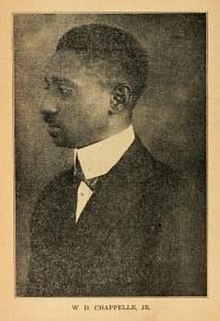IllmaticDelta
Veteran
============
Robert John Palmer - 2nd Great Grandfather of Dave Chapelle

Robert J. Palmer's daughter was Rosina C. Palmer:

Rosina was married to William David Chappelle, Sr.

===========================
W.D. and Rosina Chappelle's son - William David Chapelle, Jr.:

================================
W. D. Chappelle Jr.'s nephew - William David Chappelle III (Dave Chapelle's father):
W.D. Chappelle III married Yvonne Seon (Dave Chappelle's Mother):

found a picture of the Robert Palmer w/ wife and kids

3rd and 4th generations

.
.
I haven't delved deep into but I saw the brothers

.
.
this one (bottom right) specifically:
Harry Pelot McDonald (1923–2012)
Harry Pelot McDonald was a doctor, medical missionary, civil rights activist, and humanitarian in the second half of the twentieth century. A leader of the Fort Smith (Sebastian County) branch of the National Association for the Advancement of Colored People (NAACP), McDonald advocated for the African-American community by fighting for desegregation and increased employment opportunities.
Harry Pelot McDonald was born on September 1, 1923, in Sumter, South Carolina. He was the youngest son of Adelaide Palmer McDonald and Samuel James McDonald. Samuel McDonald worked for the railway postal service and taught at Claflin University, in addition to serving as president of the Sumter NAACP. Adelaide McDonald was a homemaker and music teacher. Harry grew up in Sumter and was educated in the local schools. He graduated as the valedictorian from Sumter’s Lincoln High School before going on to study at Morehouse College in Atlanta, where he earned a BS with honors. He then entered medical school and, at the age of twenty-two, earned his MD from Meharry Medical College in Nashville, Tennessee. Following his graduation, he interned at Harlem Hospital in New York City and then did his residency in Kansas City Hospital.
Upon the completion of his residency in 1949, McDonald established a private general practice in Fort Smith. McDonald was forced to interrupt his practice a few years later when he was drafted into the U.S. Air Force not long after the end of the Korean War. With the rank of captain, he served in Ashiya, Fukuoka, Japan from 1954 to 1956. Upon his discharge from the air force, he returned to the United States. In 1956, he married Margaret Bowling, a college professor from Columbia, South Carolina. The couple settled in Fort Smith, and there they raised four children before divorcing in 1970. In 1976, McDonald married Ruby Bultman, a school teacher from Sumter.
Over the years, McDonald became a pillar of the Fort Smith community. He served in numerous capacities with the Mallalieu United Methodist Church, and following his father’s example, was president of the local NAACP for more than a decade. In that role, he led the effort to integrate the town’s school system, collaborating with an array of state and local officials. Working with fellow activist Daisy Bates and respected civil rights attorneys Wiley A. Branton Sr. and George Howard Jr., McDonald helped lay the groundwork for the campaign that culminated in the U.S. Supreme Court’s decision in Cooper v. Aaron. McDonald personally integrated parks, skating rinks, and movie theaters, and he also conducted sit-ins at local restaurants, once leading to a white patron holding him at gunpoint. McDonald also supported other protestors, helping secure legal aid for those who needed it.
In addition, McDonald helped secure employment for the area’s young people while also providing school books and creating a local Head Start program. McDonald was a kind of one-man social service agency, with his efforts also extending to his own professions as he helped desegregate the nurse training program at the local Sparks Hospital, opening the way for black women to become registered nurses. McDonald worked with numerous Arkansas governors, formally and informally, beginning with Winthrop Rockefeller, in his effort to create jobs and secure better opportunities for the region’s black residents.
As a doctor, McDonald served on the staff at St. Edwards, Sparks, and Crawford County hospitals. He was a member of the Sebastian County and Arkansas State Medical Associations, as well as the American Medical and National Medical Associations. He also belonged to the Arkansas Medical, Dental, and Pharmaceutical Association. In addition, McDonald was a member of the Fort Smith Progressive Men’s Club and Alpha Phi Alpha fraternity.
In 1978, Governor David Pryor appointed McDonald to the Arkansas State Board of Education, and he was reappointed by Governor Bill Clinton in 1987. Clinton also named him to the Criminal Detention Facilities Review Committee in the Twelfth Judicial District in 1984. When McDonald retired from his medical practice in 1990, Governor Clinton was the keynote speaker at the retirement celebration.
During retirement, McDonald became a medical missionary. Under the auspices of the Christian Mission of Pignon, Haiti, he provided free health care in the Hospital Bienfaisance.
In 2006, Harry and Ruby McDonald moved to Richland, Washington. There, he was cared for by his youngest daughter, Maria, and her husband, Edward McNamar. McDonald died in Washington on April 15, 2012. He is buried in Walker Cemetery in Sumter, South Carolina.
Encyclopedia of Arkansas
































